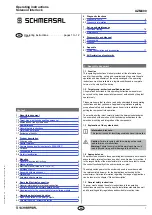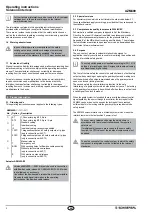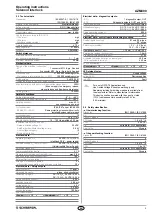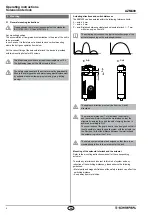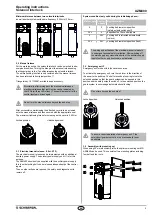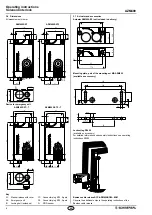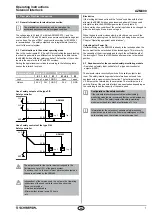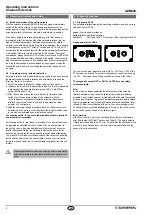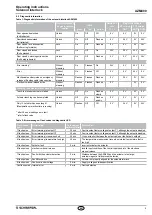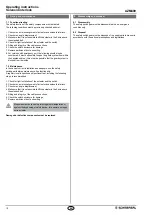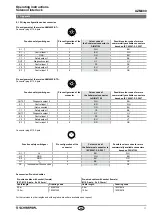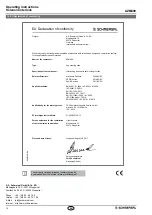
8
Operating instructions
Solenoid interlock
AZM400
EN
5. Operating principles and coding
5.1 Mode of operation of the safety outputs
With the solenoid interlock AZM400, the unlock signals immediately
switch off the safety outputs. The unlocked guard system can be
locked again as long as the actuator is within the detection range of the
solenoid interlock. In that case, the safety outputs are re-enabled.
If the safety outputs are already enabled, any error that does not
immediately affect the functionality of the solenoid interlock (e.g. too
high an ambient temperature, interference potential at the safety
outputs, cross-wire short) will lead to a warning message, the disabling
of the diagnostic output OUT of the ST version and OUT2 of the ST2
version and the delayed shutdown of the safety outputs. safety outputs
are disabled if the error warning is active for 30 minutes. The signal
combination, diagnostic output OUT of the ST version and OUT2 of the
ST2 version disabled and safety channels still enabled, can be used to
stop the production process in a controlled manner. After rectifying the
fault, the fault message is acknowledged by opening and closing the
associated safety door or by switching the operating voltage off and
on again.
5.2 Actuator teaching / actuator detection
Solenoid interlocks with standard coding are ready to use upon delivery.
Individually coded solenoid interlocks and actuators will require the
following "teach-in" procedure:
1. Switch the solenoid interlock's voltage supply off and back on.
2. Introduce the actuator in the detection range. The teach-in procedure
is signalled at the solenoid interlock, green LED off, red LED on,
yellow LED flashes (1 Hz).
3. After 10 seconds, brief yellow cyclic flashes (5 Hz) request the
switch-off of the operating voltage of the solenoid interlock.
(If the voltage is not switched off within 5 minutes, the solenoid
interlock cancels the "teach-in" procedure and signals a false
actuator by 5 red flashes).
4. After the operating voltage is switched back on, the actuator must
be detected once more in order to activate the taught actuator code.
In this way, the activated code is definitively saved!
For ordering suffix -I1, the executed allocation of safety interlock
and actuator is irreversible.
For ordering suffix -I2, the "teach-in" procedure for a new actuator can
be repeated an unlimited number of times. When a new actuator is
taught, the code, which was applicable until that moment, becomes
invalid. Subsequent to that, an enabling inhibit will be active for ten
minutes, thus providing for an increased protection against tampering.
The green LED will flash until the expiration of the time of the enabling
inhibit and the detection of the new actuator. In case of power failure
during the lapse of time, the 10-minutes tampering protection time will
restart.
Make organisational measures against possible manipulation
with other actuators in case that a standard coded variant is
used.
6. Diagnostic functions
6.1 Diagnostic-LEDs
The solenoid interlock signals the operating condition, as well as errors
through 3-colour LEDs.
green
(Power) supply voltage on
yellow
(Status) operating condition
red
(Fault)
Fault (see Table 2: Flash codes of the red diagnostic LED)
Arrangement of the LEDs
The short-circuit proof diagnostic output OUT or OUT1 and OUT2 of the
ST2 version can be used for central visualisation or control functions, e.g.
in a PLC. I t indicates the switching condition as shown in the table 1.
The diagnostic output OUT or OUT1 and OUT2 are not safety
relevant outputs!
Error
Errors, which no longer guarantee the safe function of the solenoid
interlock (internal error)s cause the safety outputs to be immediately
disabled. Any error that does not immediately affect the safe functionality
of the solenoid interlock (e.g. excess ambient temperature, safety output
to external potential, short circuit) will lead to a delayed shut-down (refer
to table 2). After the rectification of the error, the error message is reset
by opening the corresponding safety guard. Errors on the control inputs
do not cause the shut-down of the safety outputs.
Error warning
A fault has occurred, which causes the safety outputs to be disabled
after 30 minutes (LED "fault" flashes, see Table 2). The safety outputs
initially remain enabled (max. 30 min). This enables the shutdown of the
process in a controlled manner. An error warning is deleted when the
cause of error is eliminated.

